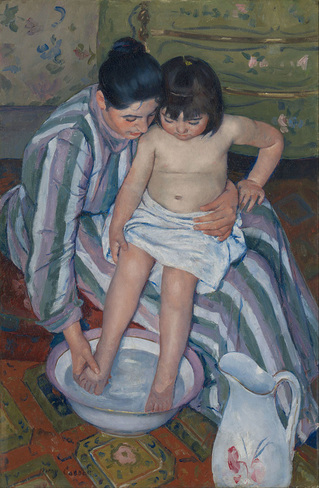|
Cassatt
1. Tired of Bonaparte with a face plumped with flattery, tired of Queen Victoria’s stony stare, she craved a subtle narrative. The artist arrives with a canvas, an easel, a palette, brushes, and a cloak caked with dry paint, fabric of fixed comet tails, to watch the mother dust, cook, feed, and sew or do whatever mothers do. The girl twirls around her, asking about paint and could she hold the brushes, mix the colours? Other children run in and out, while the mother tends to one, then to the house, then to the next child with a hummingbird’s quick precision. The artist thinks she will paint her with a bird’s slim head, elegantly feathered. 2. It’s easy to mistake this for devotion: The child anchors her weight to her mother’s thighs. The mother scrubs dirt from her daughter’s feet. Calm although her dress bruises with watermarks, she cleans the child’s limbs slowly as if polishing silver. Now imagine a cool evening draft, the fire gone out. 3. The painter sees rivers: wallpaper blurs with rivers, rivers course down the mother’s dress into the basin. She hears rivers: the trickle of water from the sponge, the girl’s light giggle. 4. The mother names every tendon and muscle, notes every birthmark and dimple under her breath as she did the day her daughter was born. 5. Propelled not by gravity, but exigency, she begged the baby to leave her body and not break it. Hours later, the baby cried, and climbed to meet her mother’s scent. 6. The river runs into a garden: rose in the mother’s dress, roses on the wall, rose in the rug, rose in the pitcher, rose in the hue of their skin, rose in the rim of the basin. 7. A vacancy, her flaccid torso. After the midwives took the baby to be weighed and measured, the mother plunged her hands in water, reclaimed her body with a soft sponge. 8. The painter finds the mother’s eyes. They dart from the child’s body to the rug to the wall to the fireplace to her feet to the hearth, to the children, then flicker in the basin water like stones on the bottom of a lake. 9. The mother sees stillness. She wants the water to cover her, to course over her body and hold her. She dreams of falling into the painting. She finds her reflection swimming in the basin, a dim minnow in a shallow pond. 10. The artist mixes whites and browns. She paints the basin over and over. Her brush siphons colour from air. More blue, some grey, some pink, and rose. Bristles splinter and fall. She evokes eyes stirring below the surface: The mother’s eyes rise then disappear. 11. The mother strokes her daughter’s foot, steals a glimpse of naked tree branches offering prayers to a gunmetal sky. 13. She hears the sudden hiss of water trembling over a pot. Wood-shock of the door closing. Catherine Prescott Catherine Prescott is the author of the chapbook The Living Ruin (Finishing Line Press, 2012). Her poems have recently appeared in Bellevue Literary Review, Cumberland River Review, Linebreak, MiPOesias, Poetry East, Rattle, The Sow’s Ear Poetry Review, and elsewhere. She holds an MFA in poetry from NYU. Catherine lives with her husband and three school-age children in Miami Beach, Florida, where she teaches poetry workshops, runs a copyediting business, and grows school gardens. www.catherineprescott.net
0 Comments
Your comment will be posted after it is approved.
Leave a Reply. |
The Ekphrastic Review
COOKIES/PRIVACY
This site uses cookies to deliver your best navigation experience this time and next. Continuing here means you consent to cookies. Thank you. Join us on Facebook:
July 2024
|




